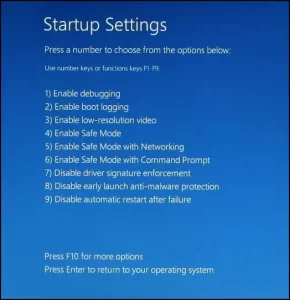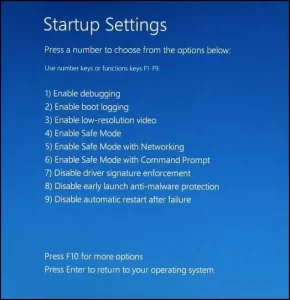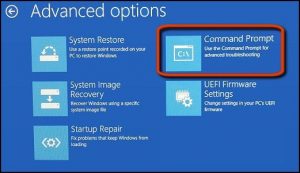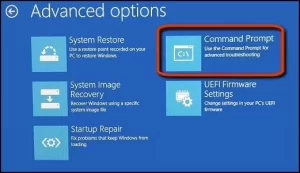How To Get In And Get Out Of Windows PC Safe Mode
Safe Mode is a diagnostic mode that allows you to use Windows with the necessary drivers. If you encounter a problem in Windows, you will be able to continue working and troubleshooting by restarting in Safe Mode. No software can be installed in Safe Mode.
In Safe Mode, Windows may look different because it uses minimal graphics to display. Also, the phrase Safe Mode is displayed in the four corners of the screen.
Note: Depending on your version of Windows, some of the graphics and information in this document may be slightly different
Enter Safe Mode from Windows
Select your operating system to enter Safe Mode.
1- Depending on your operating system, do one of the following:
Windows 10: Search and open Recovery options.
Windows 8: Search for computer settings and open them. Click Update & Recovery, then tap Recovery.
2. In the Advanced startup section, click Restart now.
3- Click on troubleshoot.

4. Advanced Select options.
5. Depending on your operating system, do one of the following:
Windows 10: Click on See more options Recovery, then select Startup Settings.
Windows 8: Click on Startup Settings.
6- Click on Restart.

Restart the computer, and another Startup Settings page will open, showing a list of different startup options.
7. Select the Safe Mode option you want from the Startup Settings list:
- Press the F4 key to enable Enable Safe Mode. Boots Safe Mode for Windows with minimal drivers and services.
- Press the F5 key to activate Safe Mode with Networking.
- Press the F6 key for Enable Safe Mode with Command Prompt. Safe Mode with Command Prompt Boots Windows into Safe Mode with Command Prompt. Usually, only IT professionals use this Mode.

8- Log in to your computer with your account name and password.
Note: To log in to Safe Mode, you must enter your Windows account login name and password. You can not do this using another method, such as a personal identification number (PIN) or fingerprint.
The computer will open in Safe Mode.
9- After finishing the troubleshooting, click on Start to exit Safe Mode.
10. Click Power, then select Restart.
The computer starts up normally.
Enter Safe Mode from outside Windows
When Windows does not start properly, you may be prompted to start in recovery mode. In this case, the Choose an option page is displayed.
If the Choose an option screen is not displayed, turn off your computer. Turn on the computer and press the ESC key several times to open the Startup menu. Press F11 to start the system recovery, then use the following steps to boot Windows in Safe Mode.
1. If prompted, select your keyboard layout, then on the Choose an option page, click Troubleshoot.

2. Click on Advanced options.
3. Click on Startup Settings. If Startup Settings is not displayed, follow the steps to enter Safe Mode without access to Startup Settings.

4. Click Restart.

Restart the computer, and another Startup Settings page will open, showing a list of different startup options.
5. Select the Safe Mode option you want from the Startup Settings list:
Press Enable F4 to enable Enable Safe Mode. Boot Safe Mode for Windows with minimal drivers and services.
Press the F5 key to activate Safe Mode with Networking. Safe Mode with Networking Boots Windows in Safe Mode allows Internet and network access.
Press the F6 key for Enable Safe Mode with Command Prompt. Safe Mode with Command Prompt Boots Windows into Safe Mode with Command Prompt. Usually, only IT professionals use this Mode.

6- Upon request, select the type of language of your keyboard and log in with the account name that has Admin Rights.
Note: To log in to Safe Mode, you must enter your Windows account login name and password. You can not do this using another method, such as a personal identification number (PIN) or fingerprint.
The computer will boot the desktop in Safe Mode.
7- After the troubleshooting, click on Start to exit Safe Mode.
Click Power, then select Restart.
The computer starts normally.
Enter Safe Mode without access to Startup Settings
In some cases, the Startup Settings option is not displayed. Open Windows in Safe Mode using Command Prompt.
1. Turn on your computer and press the ESC key several times to open the Startup menu.
2. Press F11 to start the system recovery. Select keyboard layout if requested.
3- The Choose an option page is displayed. Click on Troubleshoot.
4. Advanced Select options.
5. Click Command Prompt to open the Command Prompt window. You may need to select your account and enter your password to continue.

6- Enter the necessary command for the desired Safe Mode option. Enter the information accurately.
For Enable Safe Mode, type the following:
bcdedit / set {default} safe boot minimal and press Enter.
For Enable Safe Mode with Networking, type the following command:
bcdedit / set {default} safe boot network and press Enter.
For Safe Mode with Command Prompt, type the following:
bcdedit / set {default} safe boot minimum and press Enter, then type the following command:
bcdedit / set {default} safebootalternateshell yes and press Enter.
The operation completed successfully is displayed if you enter the command correctly.

7. Close the Command Prompt window by clicking the X in the upper right corner.
8. The Choose an option page is displayed. Select Continue and log in to your Windows system with your username and password.
Note: To log in to Safe Mode, you must enter your Windows account name and password. You can not do this using another method, such as a personal identification number (PIN) or fingerprint.
The computer will boot the desktop in Safe Mode.
Exit Safe Mode
In most cases, you can exit Safe Mode by restarting your computer. If you enter Safe Mode using Command Prompt, it will not exit Safe Mode by restarting the computer.
1. Turn off your computer, turn it on and press the ESC key several times to open the Startup menu.
2. Press F11 to start the system recovery. Select the keyboard language type on request.
3- The Choose an option page is displayed. Click on Troubleshoot.
4. Advanced Select options.
5. Click Command Prompt to open the Command Prompt window. You may need to select your account and enter your password to continue.

6- To exit Safe Mode, type the following command:
bcdedit / delete value {default} safe boot and press Enter.
7. Close the Command Prompt window by clicking the X in the upper right corner.
8- The Choose an option page is displayed. Select Continue.
The computer starts normally.
Enter Safe Mode in Windows 7 and earlier
1. Turn on or restart your computer. Hold down the F8 key before the Windows logo appears.
2. A menu will appear. You can now release the F8 key. Use the arrow keys to select Safe Mode (select Safe Mode with Networking if you need to use the Internet to solve your problem), then press Enter.
3- Your computer will be set up in Safe Mode.











